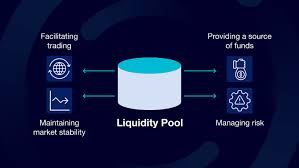Liquidity is essential for the functioning of the financial system, serving as its lifeblood. It refers to an asset’s ability to be quickly sold or exchanged for another asset without significantly affecting its price. Financial systems can come to a standstill when funds are not readily available. This applies to traditional finance and emerging blockchain-based financial products and services, known as decentralized finance or DeFi.
Liquidity Pool – an innovative solution within DeFi
Liquidity pools are a unique innovation within the DeFi ecosystem. Although DeFi shares similarities with conventional financial services, such as lending and borrowing, it relies on smart contracts, which are self-executing codes. These protocols enable users to lock their digital assets into a liquidity pool, which other participants can access. This feature distinguishes DeFi from traditional finance. In simple terms, liquidity pools are a collection of digital assets that enable trading on decentralized exchanges (DEXs) without intermediaries. Liquidity pools provide a steady supply of buyers and sellers, ensuring that trading is executed quickly and efficiently. They are an essential part of the DeFi ecosystem as they facilitate peer-to-peer trading on DEXs.
What attracts users to provide liquidity?
For any investment, the primary objective of any investment is to gain rewards or incentives, and DeFi is no exception. In DeFi, users deposit their crypto assets into a pool with other users, a process known as yield farming.
As a user, you might be wondering what benefits you can gain by providing liquidity in DeFi. By becoming a Liquidity Provider or LP, you can earn additional income on your crypto assets while still holding them. It’s a simple process of depositing your assets into a pool with other users, and then earning a portion of the fees generated from trading activities. Additionally, you can trade your assets with other LPs on a DEX and receive liquidity pool tokens representing your share of assets. By providing liquidity, you’re not only earning rewards, but you’re also contributing to the creation of liquidity that is crucial for the DEXs to function. So not only are you earning more money, but you’re also helping to keep the DeFi ecosystem thriving.
Automated Market Makers: The efficient engine that powers the system
First introduced in 2017 by a group of developers at Bancor, AMMs has gained widespread adoption in the crypto space due to their ability to provide increased liquidity, lower transaction costs, and greater accessibility for traders.
Historically, market makers played a key role in any market, the critical differentiator in the case of AMMs is the use of automation. Unlike conventional market makers, which rely on human traders to provide liquidity, AMMs employ algorithms that automatically set prices based on supply and demand, leading to increased market efficiency. As a result, liquidity providers (LPs) earn passive income through multiple revenue streams by supplying their tokens on different DeFi protocols.
Another salient point to note is that market makers have traditionally been spearheaded by institutional players who ensure liquidity by consistently buying and selling assets at equitable prices. However, DeFi has brought these tools to a wider audience, allowing smaller-scale traders to participate in markets. This has resulted in a more decentralized and democratic financial system, providing more opportunities for all. In addition to increased accessibility, using AMMs on DeFi protocols is also more cost-effective than traditional markets. Fees associated with using AMMs are typically lower, making it more affordable for all participants. This has been a significant factor in the growth of the DeFi ecosystem, which has experienced exponential growth in recent years.
How can one join liquidity pools? Which liquid pool to join?
To join a liquidity pool, one needs to choose a DeFi platform, connect the wallet, choose a liquidity pool that fits the user’s investment goals, deposit an equal amount of two tokens, and confirm the transaction. One example of a trading pair is ETH/USDT, where ETH (Ethereum) and USDT (Tether) are two different tokens that can be traded against each other. In this case, a trader could buy ETH with USDT or sell ETH for USDT, depending on their trading strategy and market conditions. As a liquidity provider, the rewards are in the form of trading fees and yield farming rewards. To discern the most fitting liquidity pools, users must undertake a comprehensive analysis taking into account the various use cases they serve. Let’s take the example of Uniswap, which is a decentralized exchange.
Since it operates on open source, It allows users to create new liquidity pools for any token without charging any fees. Another exchange called Curve, which is also built on Ethereum like Uniswap, is specialized for stablecoin trading. Curve Finance provides significant value by ensuring reduced slippage using stablecoins whose value remains almost consistent.
Notably, these pools have become an instrumental resource for on-chain insurance, yield farming, blockchain gaming, synthetic assets, and borrowing-lending protocols.
Conclusively,the concept of a liquidity pool is simple yet very powerful, as it does not have to rely on external market makers to provide liquidity to an exchange constantly. Hence, to attract a larger user base, enhancing the onboarding process and optimizing the user interface are imperative. As with all investment tools, there are some risks associated with liquidity pools. Smart contract risk is significant as hackers can potentially find a bug in the smart contract and steal assets from the liquidity pool. It is advisable to invest in pools that have been verified and audited by specialized firms to minimize the chances of being attacked.
Overall, DeFi has transformed the accessibility and inclusivity of financial systems by leveraging technology to provide access to financial tools that were once only available to institutions and high-net-worth individuals. This shift is likely to continue to impact traditional financial markets as more individuals look to participate in DeFi protocols and challenge the traditional financial landscape.


